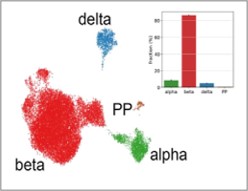Transcriptional cross species map of pancreatic islet cells
13.09.2022
Pancreatic islets of Langerhans secrete hormones to regulate systemic glucose levels. Emerging evidence suggests that islet cells are functionally heterogeneous to allow a fine-tuned and efficient endocrine response to physiological changes. A precise description of the molecular basis of this heterogeneity, in particular linking animal models to human islets, is an important step towards identifying the factors critical for endocrine cell function in physiological and pathophysiological conditions. In this study, we used single-cell RNA sequencing to profile more than 50'000 endocrine cells isolated from healthy human, pig and mouse pancreatic islets and characterize transcriptional heterogeneity and evolutionary conservation of those cells across the three species. We systematically delineated endocrine cell types and α- and β-cell heterogeneity through prior knowledge- and data-driven gene sets shared across species, which altogether capture common and differential cellular properties, transcriptional dynamics and putative driving factors of state transitions. We showed that global endocrine expression profiles correlate, and that critical identity and functional markers are shared between species, while only approximately 20% of cell type enriched expression is conserved. We resolved distinct human α- and β-cell states that form continuous transcriptional landscapes. These states differentially activate maturation and hormone secretion programs, which are related to regulatory hormone receptor expression, signaling pathways and different types of cellular stress responses. Finally, we mapped mouse and pig cells to the human reference and observed that the spectrum of human α- and β-cell heterogeneity and aspects of such functional gene expression are better recapitulated in the pig than mouse data. Here, we provide a high-resolution transcriptional map of healthy human islet cells and their murine and porcine counterparts, which is easily queryable via an online interface. This comprehensive resource informs future efforts that focus on pancreatic endocrine function, failure and regeneration, and enables to assess molecular conservation in islet biology across species for translational purposes.


